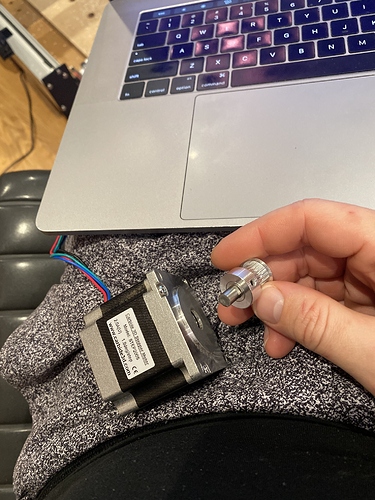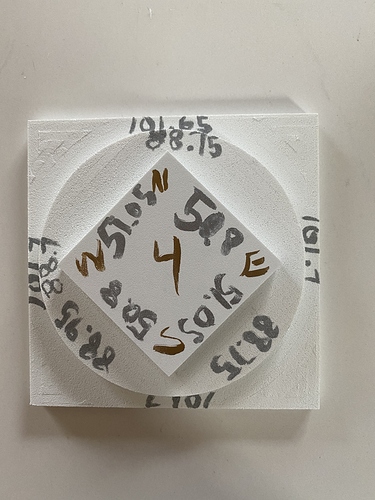uh… well that was unexpected. While cutting the last DCS test.
@WillAdams whats the chance I can get one of these locally or overnighted ASAP?
I’m feeling this right now.
A little too tight on those belts?
They look like the steel core belts, Thought you did the maintenance kit with Fiberglass belts.
How far did the pulley have the belt over the end of the shaft? My pulleys have the belts running around 1/4 inch beyond the stepper shaft… not a good scenario.
One of my projects will be to build a bearing block to mount the pulleys in, instead of it being mounted the way they are now, riding out beyond the actual shaft = shearing force, which from the looks of your pic above, that shaft was sheared off by too much leverage. I would think those steppers are designed for radial force only and not actually for leverage.
Something you might try. When you go to set the belt tension, set it to where when you try and move the associated assembly, only tighten enough that you can not easily develop slack in the belt by manually moving that associated part, then when you test for accuracy, adjust the steps required to achieve the result you want. Making guitar sounds is irrelevant, it is not a guitar. The y-movement will require a little more effort as there are two belts.
Like Liam mentions above, you will not ever get these machines perfect, but you can get them close enough.
I did not @ Liam as I do not want to get him dragged into my procedural practices (pretty sure his practices are more precise)
You know I thought about this… but I just set the $101 value below the stock value of 40 to get it = to the expected measurement. So In my mind the belt was looser and ergo providing less resistance then the stock setting would expect? Or am I thinking about that incorrectly?
I’ll take a closer look at the belts tomorrow morning. But they all look very different then my original steal core.
Not sure I follow you on the pulley, I never replaced the pulleys so if it didn’t move when it came off (it’s pretty well seated on there) it woulda been mounted there since I got the machine 1.3 years ago.
Does the black / dark spot in the middle of the shaft offer any clues to the metallurgists?
That dark spot was the last bit to go.
The shear started at the side further away from that spot. That dark spot was broken different because when the shafty started to shear, that dark spot was broken in a different direction.
so, it cracked (from too much leverage force), then all that was left holding was the dark spot and it was snapped.
BTW, I am not one of those metal lurkerests… Just have repaired a LOT of broken machinery and know how to diagnose/ prevent stuff like that.
I do not see the “Burr” that would indicate a twist, so it looks (to me) like a shear.
If I made that machine (LOLOLOLOL) the pulley would be in a solid casement with a bearing at each end, then coupled to the stepper shaft… but that’s just me.
Let us know at support@carbide3d.com and we’ll get that out to you as quickly as we can.
Send in a new e-mail to my attention and detail all the specifics and we’ll try to work out everything needed to ensure that you get back up and running and cutting to a reasonable tolerance.
Thanks Will I will do so, thoughts on this?
Welcome to the club ![]()
Most of these stepper motors are only rated for a small radial load of about 100N on the shaft. Other than the obvious bearing wearout the other failure mode the manufacturers warn of is a work hardening type process of repeated stress failure in the stepper shaft as it is constantly flexed as it rotates. It looks like you might have been a victim of that failure mode.
I’ve been considering 8mm shaft motors for my Y axes but haven’t yet found one which the Carbide electronics will be well matched to.
If you’re pushing up to the point where the stepper jumps a couple of steps then you’re finding the required minimum tension for the belts to operate ‘normally’ with both the extending and contracting sides contributing to the restoring force as the drive system needs tension on both sides of the motor ![]()
edit - that’s matching the belts to the motor sped, of course if your cutting and dynamic forces never get to breakaway torque then you can use less
These were suggested (for the X-axis at least):
I’m back up and running. I’m happy with this until i upgrade my table (the floor) and/or upgrade my base to all aluminium where I’ll spend the time trying to get rid of any sag in addtion to out-of-square.
Final $100 and $101 settings on this are:
$100=40.0106887
$101=40
Largest gap from expected measurements is .01" or .25mm and overall relative deviation from one side of the DSC to another is .05-.15mm on each shape.
Been following your story intently, thanks for the great documentation along the way!!
But I am truly amazed, how did you get a snapped shaft back up and running so fast? Did you have a spare motor?
Kindness of strangers I cannibalized someone else’s machine 40mins from me.
Thx Will,
I think that’s this model from StepperOnline
Which is slightly higher voltage req but I may give them a try, they’re pretty good value.
This topic was automatically closed 30 days after the last reply. New replies are no longer allowed.




